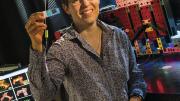Jennifer Lewis’s engineered materials look to nature as a guide. The new Wyss professor of biologically inspired engineering uses 3-D printing to build minuscule devices, from microbatteries to synthetic spider webs of threads a micron thick. Now she works to “print” biology, motivated by “a bit of naiveté mixed with a strong desire to benefit society.” Her lab develops “inks” with functional properties: cell-laden ones to print 3-D tissues, or conductive inks that flow through rollerball pens at room temperature to draw functional circuits on paper. Lewis works with high-school teachers to incorporate these inexpensive pen-on-paper electronics in their classes, so students can explore engineering through circuit design. Her educational interest draws on personal experience: despite coming from a family of engineers—her father worked for General Electric, and her sister is a chemical engineer—Lewis first encountered materials science in college at the University of Illinois. She later joined the faculty and taught there for 20 years (after earning her S.D. at MIT), returning to Cambridge for her new appointment in January. The move back East has given Lewis, an avid basketball player, a chance to pick up her squash racket again, as well. She’s also been exploring Boston through another longtime hobby: one of this fiction fan’s recent favorites is The Dante Club, a whodunit set in Civil War Cambridge, which helped immerse Lewis in her new community. She and her partner, Lori Sanders, who also studies biomaterials, live near the undergraduate Houses, “right in the heart of things,” and Lewis enjoys the intellectual stimulation of her new home: “It’s time to stretch and grow in new directions.”
Harvard bioengineering professor Jennifer Lewis prints 3-D on a micron scale
Harvard bioengineering professor Jennifer Lewis prints 3-D on a micron scale
The bioengineering professor does 3-D printing on a micron scale.

You might also like
Trump Administration Appeals Order Restoring $2.7 Billion in Funding to Harvard
The appeal, which had been expected, came two days before the deadline to file.
At Harvard, AI Meets “Post-Neoliberalism”
Experts debate whether markets alone should govern tech in the U.S.
Sam Liss to Head Harvard’s Office for Technology Development
Technology licensing and corporate partnerships are an important source of revenue for the University.
Most popular
Explore More From Current Issue

Introductions: Dan Cnossen
A conversation with the former Navy SEAL and gold-medal-winning Paralympic skier

Getting to Mars (for Real)
Humans have been dreaming of living on the Red Planet for decades. Harvard researchers are on the case.






